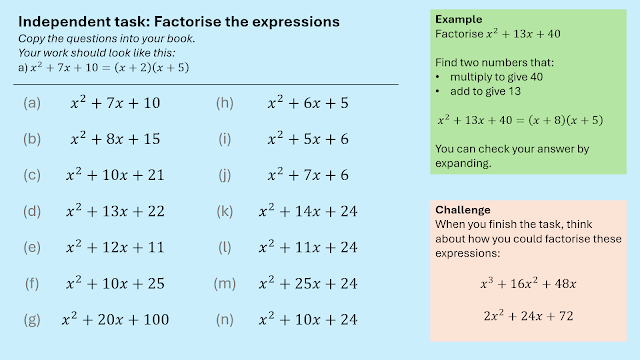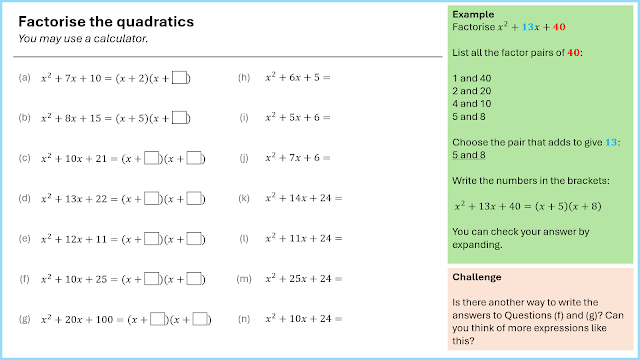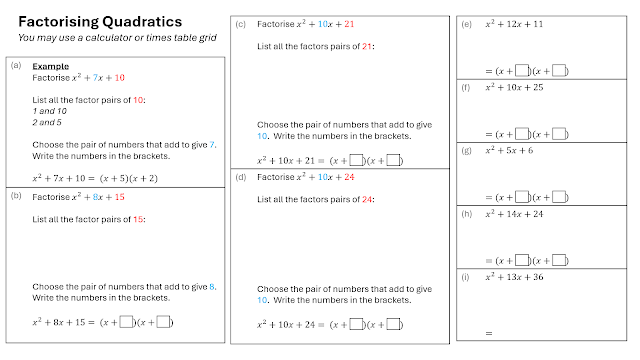There are various strategies we adopt that are probably fairly standard (e.g. students are taught in sets, and we have very large top sets to ensure our lower attainers can be taught in smaller groups, normally with TA support). We also run Entry Level Certificate for our Year 10/11 students who are likely to struggle to achieve higher than a Grade 2 at GCSE.
Tasks with Scaffolding
Maths teachers are so lucky to have an abundance of high quality resources to choose from when planning lessons. There are absolutely loads of tasks that are brilliant for middle and high attaining students, but if you’re teaching a small class of Key Stage 3 or 4 students who are working at GCSE Grades 0 – 2, it can sometimes be difficult to find suitable resources. Teachers don’t have time to make their own resources, but I feel this is something that teachers of the lowest attainers have to do fairly often. In this post I thought it might be helpful to showcase what’s available and think about some design principles.
Factorising Quadratics For All
At my school all of our Key Stage 3 classes study the same curriculum. After half term Year 9 will be factorising quadratics. This is a topic that some lower attaining students actually quite enjoy as it’s heavy on procedure and light on reasoning. But the big barrier to success in this topic is fluency in times tables and fluency in working with negative numbers.
I’ve attempted to design four tasks for this topic, each with a different level of scaffolding and challenge.
The tasks shown below are designed for different classes, but they all practise exactly the same skill: factorising monic quadratics with positive numbers. The first two tasks are intended to be projected on the board (i.e. students copy each question into their exercise book), the second two would be printed (when teaching low attainers we don’t want to add unnecessary challenge, and for some students copying from the board can be very difficult).
In this lesson on factorising positive quadratics, the teacher would model a couple of examples (known as the ‘I do’ phase of the lesson) and then in the ‘you do’ phase there may be some cold calling or mini whiteboards. The tasks below are designed for the ‘you do’ phase of the lesson where students do independent practice. Have a look at the difference between each task.
| High attainers |
 |
| Mid/higher attainers |
 |
| Mid/lower attainers |
 |
| Lower attainers |
In the second task above, which is designed for a ‘middle set’, the challenge questions are separated and an example is provided to remind students of the technique.
You can see how the amount of scaffolding increases throughout the tasks, which become more suitable for lower attainers. There are other methods for factorising quadratics (e.g. using grids) that might help too – but this post is about task design rather than methods.
I’ve put all four tasks on TES in case they’re helpful. They can easily be adapted to include negatives too. I’m not an expert task designer – the purpose of me creating these tasks was to showcase different levels of challenge and scaffolding that are possible within the same topic.
Sources of Scaffolded Resources
There are some great websites which have scaffolded resources. Here are some examples:
What have I missed? If you know a good source of scaffolded tasks, please comment below.
Also, here’s a challenge for you: it would be fantastic if some of my readers had a go at what I’ve done above for factorising quadratics: pick a topic and design three or four different tasks that all practise the same skill but are scaffolded differently, for different types of students. Please share what you come up with!
View the original article and our Inspiration here
